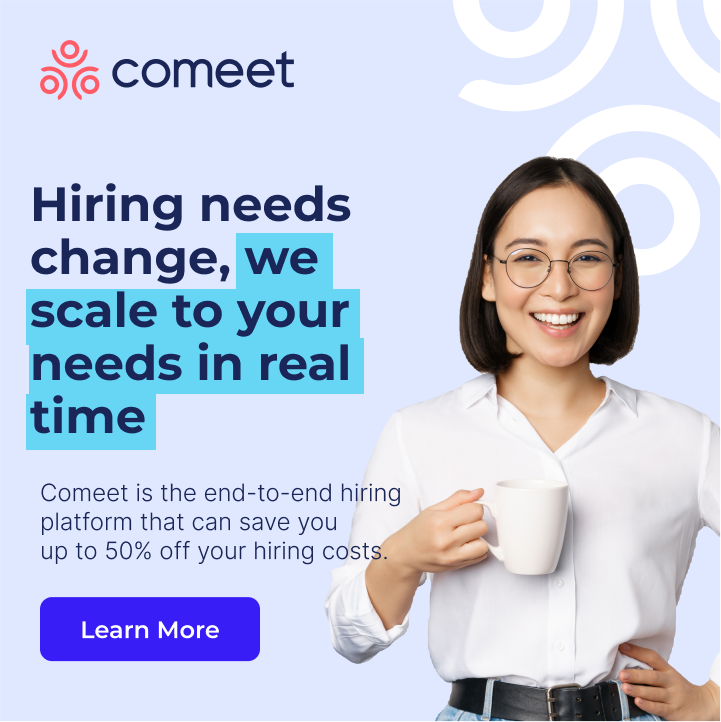When you’re building your hiring goals and full life cycle recruiting plan, it’s important to consider all the factors that could affect your ability to hire great people. The first question to ask yourself: do you have an overarching recruiting strategy? If not, you’ll need to build one as the foundation of all your other recruiting efforts.
In this post, we’ll take a closer look at everything from budgeting to strategizing, as well as how you can create hiring goals and a recruiting plan that attracts top talent to your organization. Here’s how to build your hiring goals and recruiting plan in 2023.
Establish Your Goals
Before you write your full life cycle recruiting plan, you must establish its foundation: the goals your plan is driving toward. In this specific case, your goal is to recruit top candidates from your industry to your organization. To do that, you’ll want to first ask yourself a few questions:
- What does a top performer look like to our organization?
- What will our organization look like in 2023? What are we trying to achieve?
- What specific roles are we looking to hire for?
- What skill sets do we need to fill those roles?
The answers to these questions will then inform your recruiting plan goals. View these goals as your recruiting north star; all of the tactics you use to execute the plan should reinforce these objectives.
Devise Your Recruiting Plan
Once you’ve outlined your goals, it’s time to build your recruiting plan itself. Before you write the plan, know what you plan to put in its “table of contents.” This is a high-level overview of what’s included within the plan. An effective recruiting plan will include:
- Goals. See above. Ensure your goals are well-defined, clear, and align with your company’s overall mission.
- Target audience. What skills and experiences does your ideal candidate possess? You might want to develop a candidate persona to better understand them. This persona can include their educational background, experience, and skills. Keep in mind this may vary depending on the different positions you’re hiring for.
- Key themes and messages. What are the key themes you want to convey to your candidates? What are the key attributes you’re looking for? Summarize these and develop some talking points to use when communicating with your candidates. These should reflect what you want in a new employee as well as what value your organization provides.
- Strategies. These are the high-level methods you’ll use to execute your recruiting plan.
- Tactics. These are the communication products, recruiting sources, and outreach channels you’ll use to attract new recruits. Whereas your strategies are high-level, tactics are more operational in nature. For example, posting to job boards for external recruiting is a strategy – identifying which job boards you’ll post to is a tactic.
- Timeline. What is your timeline for your recruiting plan? Even if you plan to continuously use your plan, you should schedule regular reviews to update it.
- Metrics. Finally, how do you evaluate recruiting success? With quantifiable metrics in place, you’ll know how well you’re doing.
Talk to your recruiting team once you’ve drafted your plan. Do your ideas match the reality of what you’re facing? Don’t be too ambitious, but don’t be too cautious either.
Prepare the Budget
Your recruiting plan will also include a forecast of financial resources. Before you can carry out the plan itself, you’ll need to understand how much funding you can expect to spend on your hiring goals and the subsequent recruiting plan. So how do you figure that out?
First, you’ll need to talk to your company’s leadership to determine what your recruiting budget is. You may be able to advocate for a larger budget by building out a value proposition with clear indicators of why recruiting is necessary for the company to invest. But once a budget is agreed on, you can then go about determining how much you plan to spend on each part of the recruiting process. This can include job ads, posts on job boards, and other ways to get your brand in front of new talent.
You can then calibrate how much you plan to spend depending on the state of the market. You can also adjust based on other areas you believe your company will be spending on before moving on. Though recruiting is vital, there may be other parts of the business that are prioritized financially. You’ll have to keep that in mind as you go forward.
When you’re deciding how to spend your budget, keep the following in mind:
- What activities offer you the greatest return on your investment? For example, attending career fairs may not return quite as much as spending more money on digital ads and job postings. Adjust your budget accordingly.
- Get buy-in from leadership on what you’re doing. They’ve signed off on your overall budget, but help them understand where that money is going and how you plan to use it. This will validate your efforts.
- Wherever you can invest in areas that improve the overall candidate experience (better onboarding resources, technology, etc.), do it. Always prioritize the needs and preferences of your candidates, as they’ll be the ones you need to attract to the company.
Also, ensure that others within your recruiting department or recruiting team have reviewed your proposal before taking it to the C-Suite – you want alignment from anyone who’s going to need to carry out your recruiting plan.
Track Your Metrics
As noted above, your recruiting plan should include metrics and key performance indicators (KPI) that help you evaluate how successful it is. After you’ve identified your recruiting KPIs, you then have to work on actually collecting them.
First, make sure you’re identifying the right data to collect. You can measure your average cost per hire, as well as the time it takes for you from posting a job until hiring a qualified candidate.
You’ll then want to determine how often you’re gathering your metrics. Weekly or monthly check-ins are a good place to start, as neither cadence is likely to overwhelm you.
Finally, you’ll want to understand where you collect this data. If you have a comprehensive recruiting platform, it should track this data for you. You can then use it to compile reports for your recruiting team, human resources, or your C-Suite executives.
Don’t overlook the importance of your metrics. Without them, you’ll have no way of knowing how successful your recruiting plan is. With the right metrics in place, you’ll set yourself up to monitor your progress. Then you can adapt as needed, depending on how successful your plan is.
Identify a Reasonable Timeline
In your recruiting plan, you’ll want to take a structured approach, with strategies for several time frames mapped out. Be realistic with the amount of staff and resources you have that will help you carry this plan out. If you’re a single-person team with a limited budget, it may take you longer to accomplish some of your goals. Keep this in mind as you go – you can only do so much. Your timeline should be reflective of reality.
That said, you’ll want to develop reasonable timelines, with the appropriate tactics, for several time periods. Plan for the following amounts of time in your larger recruiting plan:
- The next 6 months
- The next year
- The following year
- The next 3 years
Remember: these plans aren’t static. You’ll likely have more detail in the sections of the plan that occur sooner rather than later. You can’t anticipate what the hiring market will look like three years from now, so you may need to change that plan when the time comes. What you can do is develop a rough outline of what your recruiting plan – and ideal talent base – looks like for the next several years.
Be Realistic About Your Recruiting Needs and Capabilities
You’ll want to have a well-defined number of people you’re looking to hire in each quarter. You’ll also want to be realistic about the capabilities you have to quickly recruit and train new candidates. What organizational factors might delay or hasten these processes? How well-structured is your pipeline management process? Will your budget (or lack thereof) make hiring easier or more difficult?
Maintain a flexible, agile approach to your plan. You can’t predict every aspect of the market, your industry, or even your own organization. You may have new leadership the next year, or even the next quarter, that requires you to pivot. You also don’t know the specific roles you’ll need to fill. You may lose employees you once expected to retain.
Also, be ready for some components of your plan to not work. You shouldn’t expect a lack of success, but there’s always the possibility that you’ll fall behind in hiring due to unexpected events out of your control – 2020 was a great example of this. You may have to prioritize some roles over others if they become a necessity due to hiring issues or a talent drain in one area.
Expect the Unexpected
There are plenty of reasons why your recruiting plan may not deliver the results you hope for. Below are just a few examples of factors that can disrupt your hiring progress and that you’ll have a hard time accounting for in the planning process:
- The economy. A tight economy can make it harder to hire while also giving workers an incentive to stay put. A booming economy may make employees more likely to explore their options elsewhere.
- The hiring market. Does your company operate in an emerging industry? Do candidates in your industry have a higher standard for education or their skill set? In many cases, this can make employers more competitive with each other. That creates a better hiring market for candidates. Whatever the state of the market, you’ll want to keep your finger on the proverbial heartbeat.
- Your competitors. Who are your chief competitors? How successful are they in comparison to you when it comes to hiring? How do your salary and benefits packages stack up to them?
- The sector you’re in. If you’re in an industry that’s experiencing a downturn, you may find it harder to hire. Conversely, sectors that offer better prospects might have an easier time attracting talent. The state of your industry will likely fluctuate over the course of the next few years no matter what area you’re in.
Above All Else, Always Think Strategically
When you’re mapping out your goals and recruiting plan, it’s important to think of the long-term repercussions of what you plan to do. Don’t compose your plan in a vacuum – incorporate the perspectives of others within your company to help you determine if you’re hitting the mark with your ideas.
What planning does is help move you from a reactive posture to a proactive one. You can always adapt a plan as needed, but by understanding and identifying your recruiting needs before executing any action, you’ll pave the way for better choices along the way. It might take you a while to solidify your plan as you experience challenges along the way, but the sooner you develop and execute the plan, the sooner you’ll be able to update it as needed.
The Bottom Line: Your Recruiting Efforts Are Only as Successful as Your Strategy
Your company’s recruiting team isn’t the only group that will appreciate your efforts. Your executives, external candidates, and even current employees will all see the benefits. A well-thought-out, well-executed recruiting strategy leads to your company adding better people. This approach improves your business’s performance, which will in turn lead to a healthier bottom line. Everyone derives value from this, and you can introduce a repeatable process for recruiting and hiring the best candidates.
Of course, your efforts will only be successful if you and your recruiting staff have the right tools in place. With a platform like Comeet, you can manage the candidate experience while staying organized and on track. As your strategic recruiting partner, Comeet provides you with the tools you need to bring any recruiting plan to fruition. For more on how we can help, contact us today.





























